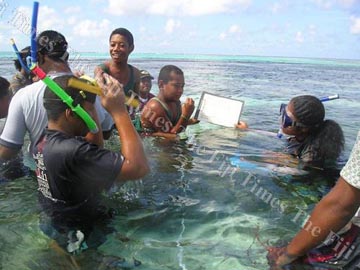|
|
||||
| From Fiji Times Online (12 April 2013) Grasses in our seas by Monifa Fiu
My first real recognition of seagrasses began about 15 years ago when a couple of us took a group of children to wade in the shallows of Maka Bay (Rotuma) purposefully, to examine the life therein. Lasting impressions were that of heads bent over or submerged in water while standing figures cradling a folder and a pencil in hand ready to write down what the others along the laid measuring tape could identify. Such experiential learning made a difference then, for our comprehension of the vital link of seagrasses to our lagoon fishing and surrounding seas that we continue annual monitoring to advocate for this remote seagrass meadow on Rotuma. This seagrass solution story describes how community groups from across the four corners of the archipelago, share similar experiential learning about coastal changes manifested that put to risk our way of life. Seagrasses are flowering plants of the sea which live and complete its entire life cycle under the sea. These underwater plants have adapted to survive in the world's coastal oceans with different species found growing in a range of marine environmental conditions. Its seagrass roots, leaves, rhizome (rootstalk) and reproductive organs for flowering, water-borne pollination and seed production set them apart from other plants in the ocean. Seagrasses also multiply (propagate) by elongating its rhizome, an underground horizontal plant stem which has roots and shoots from its nodes. Many seagrass meadows consist only of one seagrass type but there are also mixed stands of two to four species found. However, five seagrass species and one subspecies are reported in Fiji listed as Halodule pinifolia, Halodule uninervis, Halophila ovalis, Halophila ovalis ssp. bullosa, Halophila decipiens and Syringodium isoetifolium (Spalding et al. 2003; Skelton and South 2006). The shapes of seagrass shoots vary from long, thin or strap-like leaf blades to small rounded paddle-shaped leaves. The vegetative growth patterns of lateral branching and new shoot production often create dense meadows that form a canopy over the sandy bottom. The plant's structure and height of the seagrass canopy, the extent of the meadow is influenced by a number of ecological factors such as water motion caused by currents and waves. Usually the leaves are wider and weaker in areas with slow water motion, and narrower and more flexible where water movement is higher. Where present, seagrasses form the basis of many ecologically important marine habitats supporting far-reaching biotic, living communities. It has been suggested that 400 square metres of seagrass (10m long and 40m wide) can support 2000 tonnes of fish a year. Fiji's coastal fisheries productivity depends greatly on seagrass habitats. For example, juvenile emperor fish (sabutu, cabutu, kabatia, kabatiko) live in the shallow inshore areas where seagrass and mangroves before they move to deeper waters as adults (Richards et al. 1994). Seagrasses are a known resource for green turtles in the central south Pacific region. The seagrass areas in Fiji may well be providing foraging areas where turtle search for food by over half of the adult green turtles in the central South Pacific (McKenzie et al. 2007). This could be a result of lower availability of turtle food east of Fiji, where most islands are small and steep with limited areas suitable for seagrass growth. So next time when you are out wading in the shallows, take a little more time to muck around and inspect the kinds of seagrass there is to be found. There has been not much careful attention given to seagrasses however, contributions from field observations with community groups to map local seagrass areas as part of own resource planning, should be applauded. For instance, a 2008 study at Ono-i-Lau described the remote islands' clean clear lagoon sustaining lush meadows with high seagrass diversity and average 40-80 per cent growth. Similar growth patterns were found on Kabara, the mangrove fringed shores of Macuata, Naviti in Yasawa and to a lesser extent of seagrass distribution along the coral coast on mainland Viti Levu where there is coastal development. Such initiatives of keeping watch over local seagrass areas also contributes to global insight on how seagrasses could be a major local influence on seawater that could alleviate the problems of ocean acidification. It has been discovered that varieties of seagrass could help reduce the acidity of water surrounding coral reefs. This is a potential solution to endangered coral reefs vital to providing natural fishing and sea defenses for most of us living on small islands in the South Pacific. Because of increased carbon dioxide in the atmosphere, the survival of these calcium carbonate forming corals raises the acidity of the oceans. Scientists made the analogy about the risks of ocean acidification rotting our reefs, the same way that fruit and fizzy drinks can erode tooth enamel. Past studies indicate there are varieties of seagrass which can photosynthesis (complex process by plants converting carbon dioxide, water and inorganic salts into carbohydrates) quickly and efficiently that they actually turn the surrounding water more alkaline. (http://www.bbc.co.uk/news/uk-wales-south-west-wales-18558155 ) We will be at a loss without our healthy seagrasses either it be because of neglect from pollution, overfishing and climate change. So unless we as individuals or community living along a coast where seagrass thrives take local action towards a global phenomenon to protect and manage risks posed with changing seas. * Monifa Fiu is an environmental consultant and climate adaptation planner. She is also the co-ordinator for LajeRotuma Initiative. Email: monifafiu@gmail.com. |





